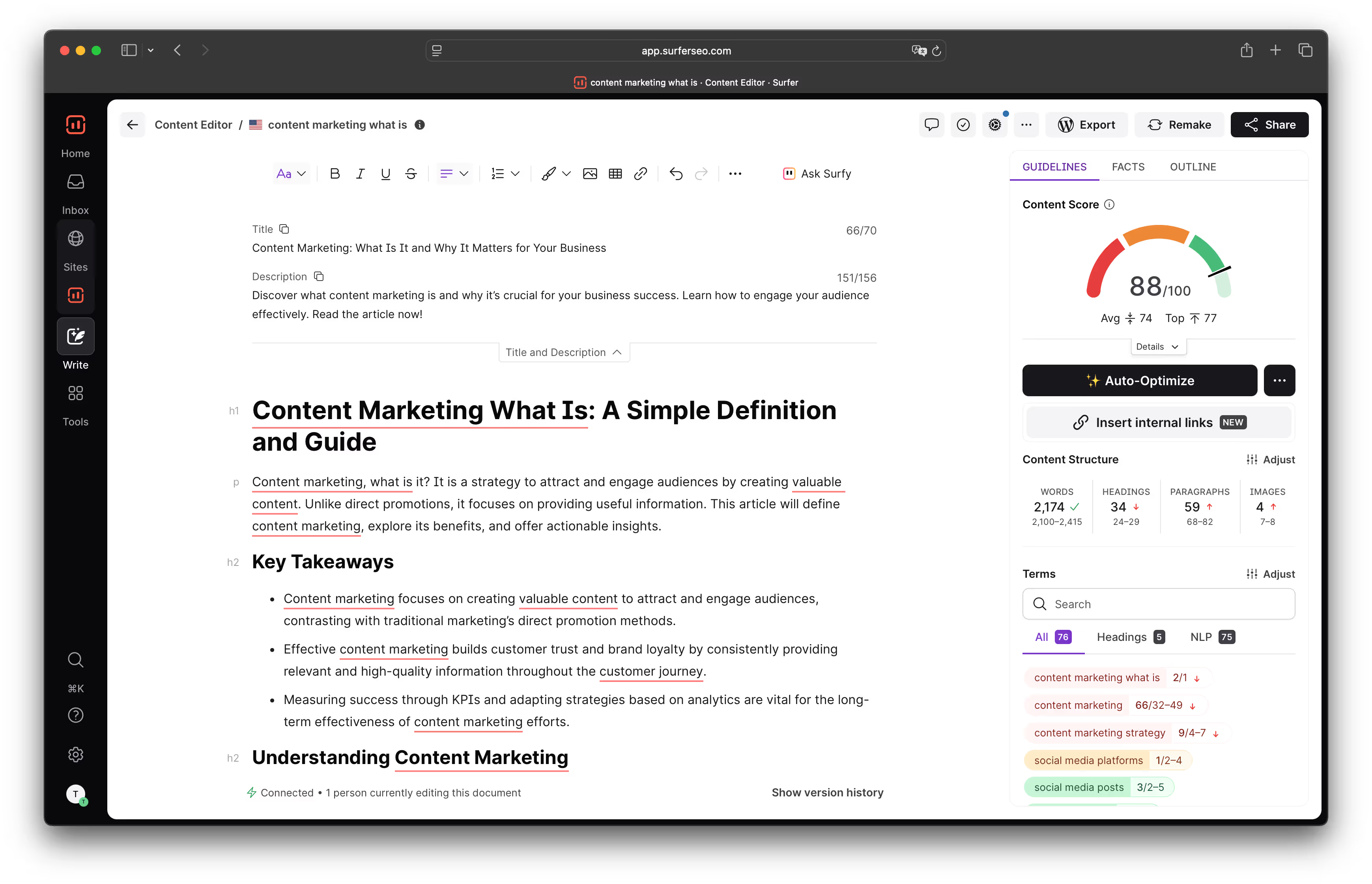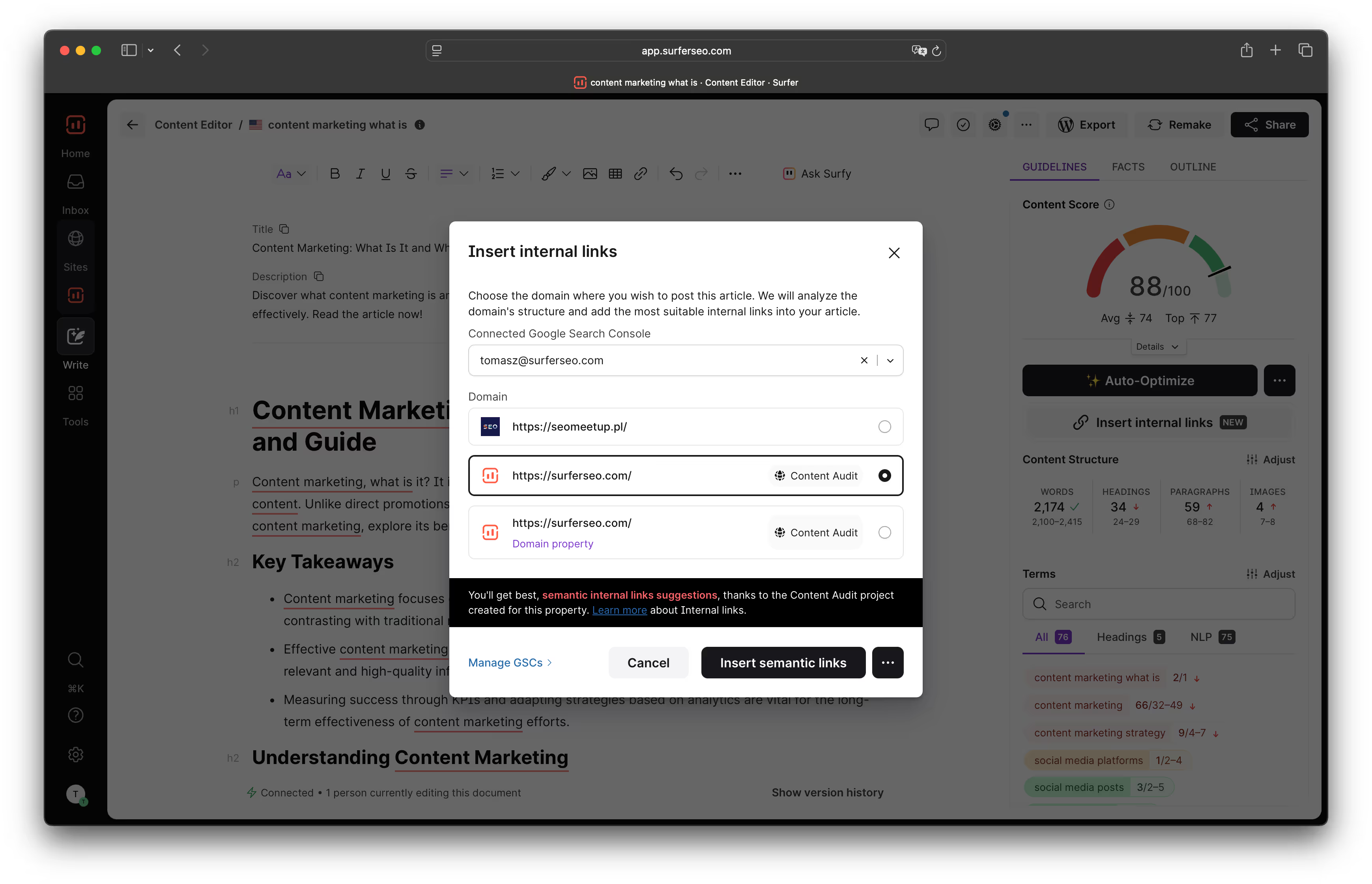I started using Ahrefs before Surfer even existed.
It was my go-to tool for keyword research, backlinks, and checking what competitors were doing. I still use it today. In fact, we use it at Surfer as well.
But something changed a few years ago.
Google started rewarding content differently. Rankings weren’t just about links or keyword stuffing anymore. Content quality started to matter more. Much more.
The strategies that worked before–building links, chasing high-volume keywords–started to lose their edge. Content became the new battleground. Google was clearly paying closer attention to what’s on the page, not just what’s pointing to it.
And that’s when a question started nagging at me:
“Why isn’t anyone building a tool that helps improve the content itself?”
It wasn’t that the idea of content optimization didn’t exist.
Tools like PageOptimizer Pro, Cora, MarketMuse, and Clearscope were already out there doing great work. But it was still niche.
A few passionate SEOs, working in what felt like a small corner of the SEO world.
We saw an opportunity to make it more accessible–to bring on-page SEO into the spotlight.
And that’s why we built Surfer.
Not to replace Ahrefs. But to do something it didn’t–and still doesn’t do well:
Optimize content so it ranks.

What you’ll find in this article:
- A clear explanation of how Surfer and Ahrefs serve different purposes–and where their features now overlap.
- Why Surfer is the stronger choice for content optimization and improving visibility in Google and LLMs.
- Where Ahrefs still leads, especially in keyword research, backlinks, technical SEO, and ad monitoring.
- How Surfer helps content teams take action, while Ahrefs provides deep research and strategic insights.
- Why using both tools together offers the most complete SEO and content strategy.
A Question I Get All the Time
As CMO of Surfer, one of the most common questions I get is:
“Okay cool, but how is Surfer different from Ahrefs or Semrush?”
The short answer:
We didn’t build Surfer to compete with them.
We built it to solve a completely different problem.
While Ahrefs and Semrush focused on backlinks, keywords, and technical audits, we focused on something they didn’t: helping teams create content that actually ranks.
But over time, the market shifted.
On-page SEO and content optimization became more important. And now?
There are areas where we actually do compete.
The difference is–we’ve been focused on this niche for 8 years, while others are just getting started.
So I actually like that question. Because in the world of content optimization, we have a head start. A big one.
That’s why, if you look for a solution that helps you create content that ranks higher on Google and LLMs such as ChatGPT, you can stop reading and pick Surfer.
But if you need full SEO coverage (from backlink analysis, through technical audit, up to content optimization), you shouldn’t choose one tool over the other.
You should use both. They complement each other perfectly.
And while Ahrefs sells their content optimization features as an add-on on top of their paid plans that costs the same as full Surfer subscription, it makes this choice even easier.
Where Surfer Wins
There are lots of SEO tools. But very few are built specifically to help you take content from average to ranking.
Here’s what makes Surfer different, and why teams choose it to power their content strategy.
If your job is to publish content that ranks, Surfer is built for that.
1. On-Page Optimization That Moves the Needle
Most content tools will tell you how many times to use a keyword or what heading to add.
That’s not optimization. That’s old-school.
And honestly? It’s not how Google–or LLMs–work anymore.
Surfer goes several steps further.
At the core of our system is the Content Score–a metric built on real-time SERP data. We analyze over 500 ranking signals across top-performing pages to show you what high-quality content actually looks like.
Compare that to Ahrefs, which only recently entered the content space with their AI Content Helper.

Their “Content Score” is built around a single idea: fact coverage.
It checks whether an article includes specific statements or trivia related to the topic. At first glance, this sounds useful—but it’s deeply flawed.
When they verify facts using AI (most likely a version of GPT), there’s no guarantee it will surface all relevant facts or do so consistently.
In fact, the list of "important" facts changes every time you generate a new document. That instability isn’t caused by SERP volatility either; it happens even when the search results stay the same.
This makes the entire approach unreliable for building consistent, high-quality content.
And look–I’m not usually the cheesy type, but I can’t help saying it:
What Ahrefs built their entire content optimization scoring around is just one feature inside Surfer.

Here's the thing: Surfer thinks like Google and LLMs do.
We don’t just check for facts, keyword usage or entity coverage: we account for all semantic variations and over 500 ranking factors.
That means “running shoes” and “shoes for runners” are seen as part of the same topic, just like Google sees them. We cluster them and suggest what’s missing based on how users actually search.
Seems like a no-brainer? Well, most of our competitors don’t do that.
We also surface content gaps–the subtopics your competitors covered but you didn’t. It’s not just about filling space. It’s about closing the loop in your content so users (as well as Google, Gemini, and ChatGPT...) can trust it’s comprehensive.
But here’s where Surfer gets really powerful.
Once you see what’s missing, you don’t need to open a blank document and write from scratch.
You can let Surfer do it for you–with your voice and style.
Upload a writing sample–an article, a page, anything–and Surfer will learn how you write.
Then it will fill the gaps in your tone with your structure, matching your brand’s personality.
Whether it’s casual, expert, punchy, or educational–we adapt to it.

This is what modern content optimization looks like:
- Data-backed
- Intuitive
- Style-aware
- High-quality & helpful
- And done in minutes
In our recent study based on 1,000,000 SERP entries we confirmed that Surfer’s optimization recommendations have a 0.28 Spearman correlation with higher Google rankings.
I get that–a 0.28 correlation with rankings might not sound massive at first glance–but in SEO, that’s a strong signal. Especially when you consider that on-page factors make up around one-third of Google’s algorithm.
So if you're creating content, this is your leverage point.
You don’t need to wonder what “good enough” looks like anymore.
We’ll show you. Then we’ll help you get there.
By the way, it is worth mentioning that Ahrefs recent data study showed that backlinks have, on average, 0.17 correlation with rankings.
So you see what can get you better results these days.
2. AI That Works for Real SEO
Let’s be honest. Most “AI content” today is fluff.
Fast? Sure. Cheap? Absolutely.
But if it doesn’t rank, what’s the point?
Surfer’s AI is different. It’s built for making your content perform in search and LLMs.

Auto Optimize analyzes your existing content, compares it to the SERP data (your competitors), and improves it in a few clicks by adding relevant entities, optimizing structure, covering content gaps and missing facts.
Combine it with your custom voice, and say goodbye to unnecessary edits.
Surfy, our AI ranking assistant, works across your optimization process. Ask questions. Get quick fixes. Make changes on the fly.
My favorite way to use Surfy? Ask it where your content lacks something compared to competitors, and then request to fill those gaps for you.
Coverage Booster scans your content for missing subtopics based on what top-ranking competitors are doing–and fills those gaps automatically.
And then there’s Auto Internal Links–a powerful feature that uses semantic analysis and live data from your connected Google Search Console and Content Audit projects. It identifies relevant internal linking opportunities across your site and inserts them intelligently, based on meaning–not just matching keywords.

This isn’t a basic “add a link to the homepage” plugin.
It understands your content, context, and structure–and helps strengthen your internal architecture the way search engines like to see.
It’s not just about “writing with AI.”
It’s about using AI to make sure your content wins.
3. Automated Weekly Content Audits
One of the biggest problems content teams face is knowing where to start.
What should we optimize?
Which pages are worth updating?
What’s underperforming–and why?
Most websites have plenty of content that is simply underleveraged, and with a few simple tweaks can bring much more traffic. That’s why I never suggest starting with writing new content, but looking at what’s already out there.
And that’s also why we built Sites.

It crawls your entire domain, identifies optimization opportunities, and gets you:
- A prioritized list of pages to update
- Topical Maps that show what to write next
- An interactive report that shows you your progress and performance against your goals
Then, it emails you a summary every week to help you stay consistent.

for pages to update and new content ideas
You can share it with your team, assign tasks, and take action–all without opening the dashboard.
This is the kind of workflow we dreamed about back when we were doing everything manually in spreadsheets.
4. Surfer Is Built for Teams
One of the most overlooked differences between Surfer and Ahrefs is how they handle collaboration.
Ahrefs is great for research–but when it comes to sharing content or working with others, it falls short.
Want to share a document? That’s only available on their enterprise plans. Want to collaborate with teammates? You’ll need to pay for more seats–even if those users are just giving feedback or checking progress.

Surfer takes a completely different approach.
Just like Google Docs, Surfer lets you share any content editor or audit via a secure link. It’s fast, free, and simple–no extra permissions, no upgrade needed. Whether you’re working with writers, editors, freelancers, or clients, they can instantly view or contribute without needing a paid account.
On top of that, Surfer includes:
- Inline commenting so your team can leave feedback or ask questions in context
- Notifications so no one misses a request or update
- Integrations with Google Docs, WordPress, and Jasper to streamline your entire content workflow

In short, Surfer is designed for collaboration–so teams can actually work together, not just look at the same data in isolation.
If your process involves more than one person (and let’s be honest, it usually does), this matters a lot.
Surfer doesn’t just optimize content–it makes the content production process smoother, faster, and easier for everyone involved.
In the next part of the post, we’ll zoom out and give Ahrefs the credit it deserves–, then explain why Surfer and Ahrefs are strongest when used together.
Where Ahrefs Is Still Best
As much as I believe in Surfer, I’ll say this without hesitation:
Ahrefs is an incredible tool.
It was my daily driver long before Surfer existed, and it still plays a big role in our stack today.
Why? Because when it comes to certain areas of SEO, Ahrefs is still the best tool out there.
So here’s what they do better than anyone.
1. Keyword and Competitor Research at Scale
This is Ahrefs’ bread and butter.
Their keyword database is massive. Not just in size, but in how quickly it updates, how deep it goes into long-tail territory, and how accurately it reflects what real users are searching for.

You plug in a topic, and instantly see:
- Search volume
- Keyword difficulty
- Click potential
- SERP features
- Historical trends
Even better? You can reverse-engineer competitors' content strategies.
See what they rank for. What brings them traffic. What’s declining. What’s rising.
Surfer offers keyword discovery too–but it’s lighter by design.
If competitive research and long-tail planning are core to your workflow, Ahrefs gives you the full map.
2. Still the Best Backlink Tool in the Game
Let’s be honest: backlink data is still one of the trickiest things to get right.
Ahrefs built their reputation on it–and for good reason. Their crawler is second only to Google’s (and in some datasets, faster than Bing’s). That gives them a massive edge in link discovery.

You can:
- Audit your own backlink profile
- Discover broken links or lost domains
- Find linking patterns across industries
- Analyze how your competitors are building authority
- Identify link opportunities in places you didn’t even think to look
No fluff, no inflated metrics. Just the data.
That said, there’s an important caveat worth highlighting.
Even Ahrefs’ own 2024 study found that backlinks today have a weaker correlation with rankings than many assume (0.17 on average).
In fact, their analysis proved that Surfer’s Content Score (with a 0.28 correlation) is stronger than the link-based metric.
Does that mean backlinks don’t matter?
No–they still do. But the game is shifting.
With the rise of LLMs like ChatGPT, Perplexity, and Gemini, the value of a “mention” is becoming just as important as the link itself. These AI systems don’t rely on dofollow tags–they rely on associating brands and content with topics.
And that’s where Ahrefs is still useful.
You can now think of it not just as a backlink tool, but as a mention discovery engine–a way to uncover where your brand (or your competitors’) is showing up, what context it's appearing in, and where new visibility opportunities exist.
So yes, links still matter.
But strategic placement, relevance, and association matter even more now.
Ahrefs helps you find those high-leverage spots.
Surfer on the other hand doesn’t offer backlink features.
3. Paid Search Visibility
This is one of the more underrated features in Ahrefs–but it’s one I’ve used often.
If you’re working on both organic and paid campaigns, or just want to understand who’s bidding on your keywords, Ahrefs lets you see it.

You’ll know:
- Which competitors are spending on ads
- What copy they’re using
- Which pages they’re promoting
- How long those ads have been running
Why does this matter?
Because PPC signals what competitors value.
If they’re paying to promote a keyword, it’s probably converting.
That’s gold for content strategists–especially if you’re mapping commercial intent.
Surfer doesn’t touch this area, and we don’t have plans for implementing it, so if you care about it, Ahrefs is a better choice.
4. Technical SEO That’s Not Just Warnings–It’s Fixes
Technical site audits are standard in most SEO platforms now.
What sets Ahrefs apart is how they combine detection with execution.

Their crawler picks up on all the usual suspects:
- Broken links
- Redirect chains
- Slow-loading pages
But then, they go one step further.
If your site is on Cloudflare, you can apply fixes directly through Workers. Or inject improvements via JS snippets–without touching your CMS.
For many teams, this saves hours of dev time.
If your site has structural issues that impact rankings, Ahrefs will help you find–and fix–them.
Surfer vs. Ahrefs: Feature Comparison
Final Thoughts: Choose the Tool That Works for How You Work
Most SEO teams don’t need 50 features.
They need the handful that actually move the needle–consistently, across the workflows they run every day.
If your team is focused on content creation, optimization, auditing, and monitoring, Surfer is purpose-built for that.
It’s not trying to do everything. It’s focused–and better because of it.
- Surfer doesn’t just help you write–it helps you write better, based on live SERP data.
- It doesn’t just show you what’s missing–it fills content gaps automatically, using your voice and tone.
- It doesn’t just audit your content–it gives you weekly, actionable plans with Sites.

Meanwhile, if your work revolves around backlink audits, competitive intelligence, or technical SEO, Ahrefs is still the go-to tool. Their link index is unmatched. Their keyword research is deep. Their audit tools are fast and flexible. And for PPC data and competitive monitoring, they’re tough to beat.
So what’s the answer?
Use both–if you can.
That’s what we do. And it’s what many of our customers do, too.
But if you’re choosing a tool to run your content operation, Surfer is the one that’s actually built for that job.
It doesn’t stop at features. Surfer’s usability and support are a huge part of why people stick with it.
- According to G2, Surfer has a higher overall rating (4.8) than Ahrefs (4.5).
- Surfer’s UX is cleaner, faster, and easier to navigate. You’ll feel it from day one.
- You’ll get human support from real people, not “read documentation” or ticket black holes.
- Ready-to-rank AI articles are included–while Ahrefs doesn’t offer it at all.
- Collaboration is free. Shareable links, WordPress and Google Docs integrations, and team workflows are all built-in–without charging you for more seats (as Ahrefs does).

So yes, Ahrefs is still a powerhouse.
But when it comes to content–strategy, writing, optimization, monitoring–Surfer leads. It’s focused. It’s effective. And it’s built to help teams win.
If you can use both, you’ll get the best of both worlds.
If you have to choose one for content?
Make it Surfer.





.avif)